
Video and Podcast Links to the 1921 Tulsa Race Massacre
- Subject:
- U.S. History
- Material Type:
- Activity/Lab
- Author:
- Amit
- Date Added:
- 06/01/2021

Video and Podcast Links to the 1921 Tulsa Race Massacre
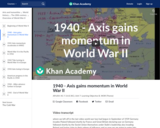
In this second video giving an overview of World War II, we see Germany and the Axis powers only continue to gain momentum in 1940.
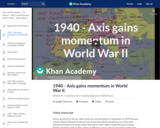
In this second video giving an overview of World War II, we see Germany and the Axis powers only continue to gain momentum in 1940.

In 1941, the Axis gains further momentum with control of most of Continential Europe. Hitler decides to break pact and invade Stalin's Soviet Union. United States enters World War II after Japanese attack on Pearl Harbor.

In 1941, the Axis gains further momentum with control of most of Continential Europe. Hitler decides to break pact and invade Stalin's Soviet Union. United States enters World War II after Japanese attack on Pearl Harbor.

In 1942 we see the Axis get pushed back in North Africa and get bogged down in the Soviet Union. The tide of war turns in favor of the Allies.

In 1942 we see the Axis get pushed back in North Africa and get bogged down in the Soviet Union. The tide of war turns in favor of the Allies.

In 1943, the tide really turns in favor of the Allies in World War II. They are able to push the Axis out of N.Africa and force a surrender from Italy (along with Mussolini being deposed). The Soviets are able to start pushing the Axis out of the Soviet Union.

In 1943, the tide really turns in favor of the Allies in World War II. They are able to push the Axis out of N.Africa and force a surrender from Italy (along with Mussolini being deposed). The Soviets are able to start pushing the Axis out of the Soviet Union.
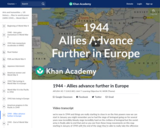
As we go into 1944, we see the allies land at Normandy, liberate France and face Germany in their last major counteroffensive at the Battle of the Bulge. On the Eastern Front, the Soviets end Siege of Leningrad and begin to push through Poland and Romania. In the south, Allies land in southern France and take Rome.

As we go into 1944, we see the allies land at Normandy, liberate France and face Germany in their last major counteroffensive at the Battle of the Bulge. On the Eastern Front, the Soviets end Siege of Leningrad and begin to push through Poland and Romania. In the south, Allies land in southern France and take Rome.
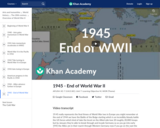
1945 marks the end of World War II. V-E Day (Victory in Europe Day) is May 8th 1945. War doesn't end in the Pacific until August of 1945 with the atomic bombing of Hiroshima and Nagasaki.
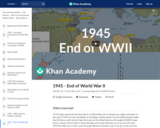
1945 marks the end of World War II. V-E Day (Victory in Europe Day) is May 8th 1945. War doesn't end in the Pacific until August of 1945 with the atomic bombing of Hiroshima and Nagasaki.

This page from the Volcano World website contains a summary account of the 1959 eruption at Kilauea Iki which is illustrated by photographs and videos.

Students will create a compilation of 20 images from the 1960s and explain the significance of each image.

In which John Green teaches you about a time of relative tumult in the United States, the 1960s. America was changing rapidly in the 1960s, and rights movements were at the forefront of those changes. Civil Rights were dominant, but the 60s also saw growth in the Women's Movement, the LGBT Rights Movement, the Latino Rights Movement, and the American Indian Movement. Also, Americans began to pay a bit more attention to the environment. All this change happened against the backdrop of the Cold War and the Rise of Conservatism. It was just wild. John will teach you about sit-ins, Freedom Rides, The March on Washington, MLK, JFK, LBJ, and NOW. Man, that is a lot of initialisms. And one acronym.
Chapters:
Introduction: The 1960s
The Civil Rights Movement
Martin Luther King, Jr.
JFK and the Civil Rights Movement
LBJ, the Civil Rights Act, and the Great Society
Inequality in Urban America
Malcolm X, Black Power, and the Black Panther Party
Student Activism and Other Civil Rights Movements of the 1960s
Mystery Document
The Environmental Movement
The American Feminist Movement
The Supreme Court During the Warren Era
1968 was kind of a big year
Credits

This video adapted from the Valdez Museum & Historical Archive, explores what happened during the Great Alaska Earthquake of 1964 through original footage, first-person accounts, and animations illustrating plate tectonics.

Overview
Thousands of high school students walked out of classes in East Los Angeles in 1968 to protest unequal treatment of Mexican Americans in the public education system. Among the students' concerns were classes that omitted Hispanic history, a lack of bilingual teachers and a system that steered Chicano students to vocational training rather than college-prep classes.

Students will research and develop 3 questions over the the 1970s which can be answered by the citation of at least 3 pieces of evidence.

In which John Green returns for a dystopian new season of Crash Course Literature! We're starting with George Orwell's classic look at the totalitarian state that could be in post-war England. Winston Smith is under the eye of Big Brother, and making us think about surveillance, the role of government, and how language can play a huge part in repressive regimes.